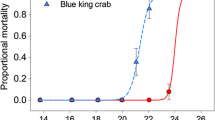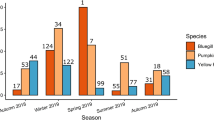Summary
Orconectes rusticus currently is undergoing an explosive range expansion in the midwestern U.S.A., but information on the potentially important effects of water temperature on the species' biology is lacking. The thermal ecology of O. rusticus in southwestern Ohio, U.S.A., was examined by determining 1) the effects of four water temperatures (16, 20, 25, and 29°C) on survival and growth of juveniles, 2) the responses of juveniles and adults to a thermal gradient (7–27° C), and 3) the thermal tolerances (critical thermal maximum, CTMax, and critical thermal minimum, CTMin) of free-living, field-acclimatized juveniles and adults on a biweekly basis throughout the summer. Month-long growth experiments predicted maximum growth rates of juveniles at water temperatures between 26 and 28°C, but greatest survival between 20 and 22° C. Laboratory-acclimated (22° C) adults and field-acclimatized (2.5° C) juveniles both had an acute preferred temperature of 22° C. CTMaxs and CTMins of juveniles were 0.5–2.6° C higher than those of adults throughout the summer, suggesting that juveniles were exposed to water temperatures 1.5–6.8° C warmer than those of adults. Juvenile and adult O. rusticus prefer habitats where water temperatures favor maximum survival, but they usually are not found together in the same habitat; adults apparently displace the juveniles into warmer habitats. Warmer temperatures can decrease survival of juveniles but improve their growth rates, leading to enhanced fecundity and competitive ability. The past and future success of O. rusticus in expanding its range may depend, in part, on the species ability to adjust to new thermal environments occupied by other species of crayfish.
Similar content being viewed by others
References
Avault JW Jr (1983) Crayfish species plan for the United States: aquaculture. In: Goldman CR (ed) Freshwater crayfish V. AVI Publishing Company, Incorporated, Westport, Connecticut, pp 528–533
Berrill M (1978) Distribution and ecology of crayfish in the Kawartha Lakes region of southern Ontario. Can J Zool 56:166–177
Berrill M, Hollett L, Margosian A, Hudson J (1985) Variation in tolerance to low environmental pH by the crayfish Orconectes rusticus, O. propinquus, and Cambarus robustus. Can J Zool 63:2586–2589
Bills TD, Marking LL (1988) Control of nuisance populations of crayfish with traps and toxicants. Progr Fish-Cult 50:103–106
Butler MJ IV (1988) Evaluation of possible reproductively mediated character displacement in the crayfishes, Orconectes rusticus and O. sanbornii. Ohio J Sci 88:87–91
Butler MJ IV, Stein RA (1985) An analysis of the mechanisms governing species replacements in crayfish. Oecologia 66:168–177
Capelli GM (1982) Displacement of northern Wisconsin crayfish by Orconectes rusticus (Girard). Limnol Oceanogr 27:741–745
Casterlin ME, Reynolds WW (1977) Behavioral fever in crayfish. Hydrobiologia 56:99–101
Claussen DL (1980) Thermal acclimation in the crayfish Orconectes rusticus and O. virilis. Comp Biochem Physiol 66A:377–384
Craig WJ Jr (1974) Physiological ecology of the commensal crabs, Polyonyx gibbesi Haig and Pinnixa chaetopterana Stimpson. Oecologia 15:235–244
Crawshaw LI (1974) Temperature selection and activity in the crayfish, Orconectes immunis. J Comp Physiol 95:315–322
Fielder DD (1972) Some aspects of the life histories of three closely related crayfish species Orconectes obscurus, O. sanbornii, and O. propinquus. Ohio J Sci 72:129–145
Hall LW Jr, Cincotta DA, Stauffer JR Jr, Hocutt CH (1978) Temperature preference of the crayfish Orconectes immunis. Arch Environ Contam Tox 7:379–383
Hlohowskyj I, Wissing TE (1987) Seasonal changes in the thermal preferences of fantail (Etheostoma flabellare), rainbow (E. caeruleum), and greenside (E. bennioides) darters. In: Matthews WS, Heins DC (eds) Community and evolutionary ecology of North American stream fishes. University of Oklahoma Press, Norman, pp 105–110
Hobbs HH Jr (1974) A checklist of the North and Middle American crayfishes (Decapoda: Astacidae and Cambaridae). Smiths Contrib Zool No 166
Hobbs HH III, Jass JP (1988) The crayfishes and shrimp of Wisconsin (Cambaridae, Palaemonidae). Milwaukee Public Museum
Jezerinac RF (1982) Life-history notes and distribution of crayfishes (Decapoda: Cambaridae) from the Chagrin River basin, northeastern Ohio. Ohio J Sci 82:181–192
Jezerinac RF (1986) Endangered and threatened crayfishes (Decapoda: Cambaridae) of Ohio. Ohio J Sci 86:177–180
Jones PD, Momot WT (1983) The bioenergetics of Orconectes virilis in two pothole lakes. In: Goldman CR (ed) Freshwater crayfish V. AVI Publishing Company, Incorporated, Westport, Connecticut, pp 192–209
Layne JR Jr, Manis ML, Claussen DL (1985) Seasonal variation in the time course of thermal acclimation in the crayfish Orconectes rusticus. Freshw Invert Biol 4:98–104
Layne JR Jr, Claussen DL, Manis ML (1987) Effects of acclimation temperature, season, and time of day on the critical thermal maxima and minima of the crayfish Orconectes rusticus. J Therm Biol 12:183–187
Lodge DM, Beckel AL, Magnuson JJ (1985) Lake-bottom tyrant. Nat Hist 94:33–37
Loring MW, Hill LG (1976) Temperature selection and shelter utilization of the crayfish, Orconectes causeyi. Southwest Nat 21:219–226
Lorman G (1980) Ecology of the crayfish Orconectes rusticus in northern Wisconsin. Doctoral dissertation, University of Wisconsin, Madison
Lorman JG, Magnuson JJ (1978) The role of crayfishes in aquatic systems. Fisheries 3:8–11
Mathur D, Schutsky RM, Purdy EJ Jr (1982) Temperature preference and avoidance responses of the crayfish, Orconectes obscurus, and associated statistical problems. Can J Fish Aquat Sci 39:548–553
McCauley RW, Casselman JM (1981) The final preferendum as an index of the temperature for optimum growth in fish. In: Proceedings of the world symposium on aquaculture in heated effluents and recirculation systems, volume 2. Student Aquaculture Association of the United Nations, Berlin, pp 81–93
Momot WT (1967) Population dynamics and productivity of the crayfish, Orconectes virilis, in a marl lake. Am Midl Nat 78:55–81
Momot WT (1984) Crayfish production: a reflection of community energetics. J Crust Biol 4:35–54
Momot WT, Gowing H, Jones P (1978) The dynamics of crayfish and their role in ecosystems. Am Midl Nat 99:10–35
Momot WT, Hartviksen C, Morgan G (1988) A range extension for the crayfish Orconectes rusticus: Sibley Provincial Park, northwestern Ontario. Can Field-Nat 102:547–548
Mundahl ND (1989) Seasonal and diel changes in thermal tolerance of the crayfish Orconectes rusticus, with evidence for behavioral thermoregulation. J N Am Benthol Soc 8:173–179
Nolfi JR (1983) Commercialization of Vermont crayfish species (Orconectes immunis and Orconectes virilis): putting theory into practice. In: Goldman CR (ed) Freshwater crayfish V. AVI Publishing Company, Incorporated, Westport, Connecticut, pp 429–441
Peck SK (1985) Effects of aggressive interaction on temperature selection by the crayfish, Orconectes virilis. Am Midl Nat 114:159–167
Prins R (1968) Comparative ecology of the crayfishes Orconectes rusticus and Cambarus tenebrosus in Doe Run, Meade County, Kentucky. Int Rev Ges Hydrobiol 53:667–714
Reynolds WW, Casterlin ME (1979) Behavioral thermoregulation and the “final preferendum” paradigm. Am Zool 19:211–224
Roberts TW (1944) Light, eyestalk, chemical and certain other factors as regulators of community activity for the crayfish Cambarus virilis Hagen. Ecol Monogr 14:359–392
Smith DG (1981) Evidence for hybridization between two crayfish species (Decapoda: Cambaridae: Orconectes) with a comment on the phenomenon in Cambarid crayfish. Am Midl Nat 120:405–407
Sommer TR, Goldman C (1983) The crayfish Procambarus clarkii from California ricefields: ecology, problems, and potential for harvest. In: Goldman CR (ed) Freshwater crayfish V. AVI Publishing Company, Incorporated, Westport, Connecticut, pp 418–428
Spoor WA (1955) Loss and gain of heat-tolerance by the crayfish. Biol Bull 108:77–87
Sprague JB (1963) Resistance of four freshwater crustaceans to lethal high temperatures and low oxygen. J Fish Res Board Can 20:387–415
St John FL (1988) Distribution and status of Orconectes (Rhoadesius) sloanii (Bundy) (Crustacea: Decapoda: Cambaridae). Ohio J Sci 88:202–204
Westman K (1973) Cultivation of the American crayfish Pacifastacus leniusculus. Abrahamsson S (ed) Freshwater crayfish. Studentliteratur, Lund, Sweden, pp 211–220
Author information
Authors and Affiliations
Rights and permissions
About this article
Cite this article
Mundahl, N.D., Benton, M.J. Aspects of the thermal ecology of the rusty crayfish Orconectes rusticus (Girard). Oecologia 82, 210–216 (1990). https://doi.org/10.1007/BF00323537
Received:
Revised:
Accepted:
Issue Date:
DOI: https://doi.org/10.1007/BF00323537




